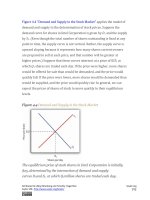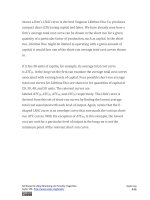Authors libby rittenberg 106
Bạn đang xem bản rút gọn của tài liệu. Xem và tải ngay bản đầy đủ của tài liệu tại đây (291.3 KB, 1 trang )
Formed by the Maastricht Treaty of 1993, The European Union represents
one of the boldest efforts of our time to exploit the theory of comparative
advantage. The Treaty sought to eliminate all trade barriers between the
European Union’s members. It established a European Parliament and a
European Central Bank. The Bank introduced the euro in 1999, a currency
that replaced national currencies such as the German deutsche mark and
the French franc. At first, the euro was used only for transactions between
banks. 320 million people in 15 EU nations (Austria, Belgium, Cyprus,
Finland, France, Germany, Greece, Ireland, Italy, Luxembourg, Malta, the
Netherlands, Portugal, Slovenia, and Spain) used the euro by 2008. While
the dollar continues to be more widely used, the total value of euros in
circulation exceeds that of dollars.
The movement toward European integration can be dated back more than
half a century. In 1950, just five years after a war that had devastated
much of the world, Robert Schuman, the French Minister of Foreign Affairs,
proposed a union between France and Germany to cooperate in the
production of iron and steel. In the context of the time, Schuman’s proposal
was a radical one. World War II had begun with Germany’s attempt to
seize control of Europe—and ultimately the world. Japan and Italy joined
Germany in this effort. Germany had captured France; France had been
liberated in 1944 by the Allied invasion in Normandy. The proposal for
cooperation between two countries that had been the most bitter of
enemies was a revolutionary one. Schuman’s speech, delivered on May 9,
1950, is celebrated throughout Europe as “Europe Day.”
In effect, the European Union has created an entity very much like the
United States. Countries within the European Union retain their own
languages and cultural differences, but they have ceded a remarkable
Attributed to Libby Rittenberg and Timothy Tregarthen
Saylor URL: />
Saylor.org
106









